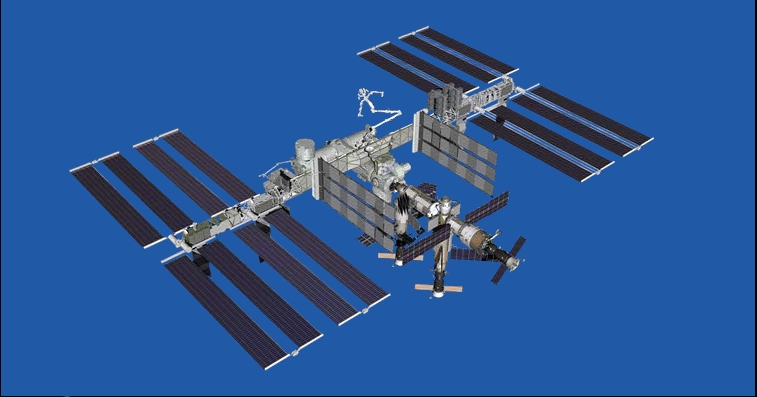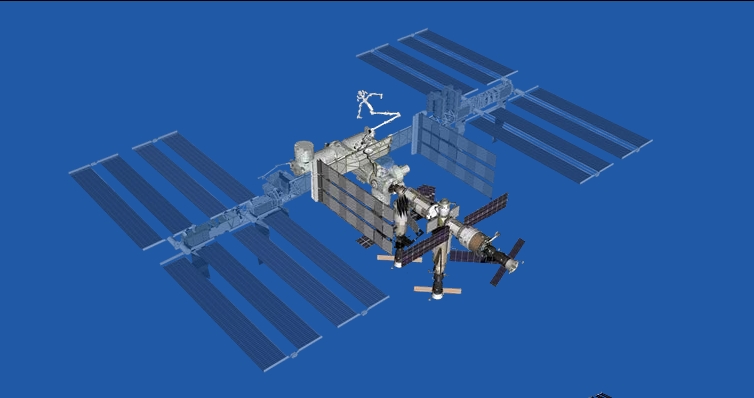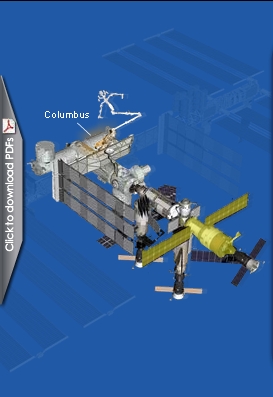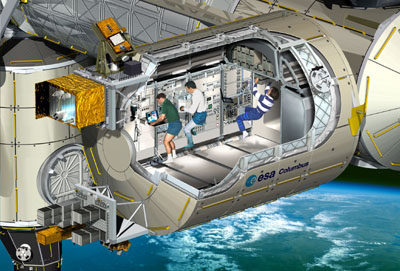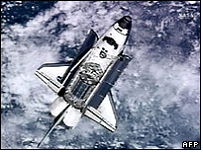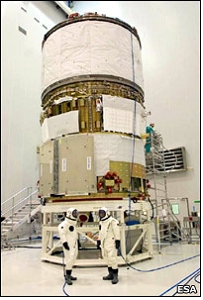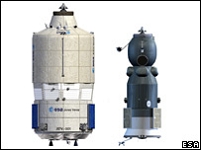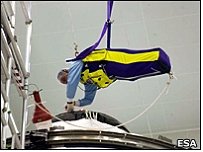European lab spacewalk delayed for a day
Sat Feb 9, 2008 5:23pm
Shuttle lifts off to space
By Irene Klotz
HOUSTON (Reuters) - U.S. space shuttle Atlantis arrived at the International Space Station on Saturday, but the installation of its primary cargo, a European science laboratory, will be delayed for a day due to an astronaut health problem, NASA said.
Space agency officials would not disclose who was ill or what the problem was, but said German astronaut Hans Schlegel, 56, would not take part as planned in the spacewalk to attach the lab to the station.
He will be replaced by fellow Atlantis crewmember Stan Love, said mission management team leader John Shannon.
The installation of the $1.9 billion Columbus lab, Europe's main contribution to the $100 billion space station, will take place on Monday instead of on Sunday, Shannon said in a briefing at Johnson Space Center in Houston.
NASA rules prevent much disclosure about astronaut health problems, but Shannon said the illness "is not life-threatening."
Schlegel flew on a shuttle in 1993 and was scheduled to take part in the three spacewalks planned for this mission. His status for the rest of the flight was unclear.
News of the delay followed Atlantis' docking with the station 200 miles above Earth on Saturday, ending a two-day orbital journey that began on Thursday with launch from Florida.
After docking, the shuttle crew floated into the station to warm greetings from station commander Peggy Whitson and her two crewmates.
*****************************************
유럽 첫 영구우주실험실인 콜롬버스
Shuttle docks with Space Station
Saturday, 9 February 2008, 22:02
Columbus will be the site of an intensive research programme
Space shuttle Atlantis has docked at the International Space Station (ISS), where it is to deliver Europe's Columbus science laboratory.
But the laboratory's installation has been delayed, as an astronaut who was to spacewalk on Sunday became ill.
The lab is the first part of the ISS the European Space Agency will control.
The Columbus laboratory cost about $2bn and has room for three researchers in fields ranging from crop breeding to the development of advanced alloys.
Inspection
Hours after the docking, a Nasa spokesman announced that the spacewalk to attach Columbus to the ISS, originally scheduled for Sunday, was being delayed by 24 hours.
Although no reason was given for the delay, the spokesman also said that Hans Schlegel, the German astronaut who was to have performed the spacewalk, had fallen ill.
Before docking, the crew guided Atlantis in a back-flip manoeuvre that will allow crew on the space station to photograph the shuttle's protective heat-resistant tiles.
COLUMBUS FACTS
Total length - 6.8m
Diameter - 4.5m
Volume - 75 cu m
Launch mass - 12.8t
Operation - 3 crew
Cabin temp - 16-27C
Total power - 20 kW
Engineers on earth will check for any possible damage that may have been done to the tiles during take-off: a routine safety measure since the shuttle Columbia disintegrated on re-entering the earth's atmosphere in 2003.
The 7m-long (24ft), 4.5m-wide (14ft), 12.8-tonne laboratory will be manoeuvred into position by the shuttle's robotic arm, and docked to the station's Harmony Node 2 connector.
Esa astronaut Leopold Eyharts will be staying on the station to commission Columbus, a process that should take a few weeks to complete fully.
Its installation will mean Esa becomes a full member of the orbital project.
Atlantis was launched from the Kennedy Space Center in Florida on Thursday, and is due to return to earth on Monday.
Once the lab is in place, an intensive programme of research in weightless surroundings will begin.
The experiments will also help researchers better understand the physiological demands of long-duration spaceflight, something that will be important if humans are ever to colonise the Moon or travel to Mars.
*********************************
Space cargo ship near completion
By Jonathan Amos
Science reporter, BBC News
The last fuelling procedure begins on Friday morning
The launch and docking windows for the ATV, Europe's huge new space-station resupply ship, have been set.
The Automated Transfer Vehicle (ATV) will be lofted in the 22 February to 8-9 March time frame, European Space Agency (Esa) officials say.
The 20-tonne vessel will then attach itself to the international outpost during one of two windows; in early March, or in late March to early April.
ATV is the biggest, most sophisticated spacecraft Europe has attempted to fly.
Its preparation at the Kourou spaceport in French Guiana is very nearly complete.
This Friday, engineers will start the final stage of fuelling, adding 2.7 tonnes of oxidiser to the ship's propellant system.
Once this is done, and major headway has been made on the final 200 or so items on an "open work list", the ATV will be moved out of Kourou's giant S5 integration halls and taken to the Baf (Final Assembly Building) where it will be mated with its Ariane 5 launcher.
SPACE STATION CARGO TRUCKS
▴ATV (l) will resupply the ISS with up to 7,500kg of cargo
▴Capacity is three times that of the Russian Progress craft (r)
▴Deliveries will include science equipment, food and clothing
▴Large tanks can transport vital air, water and fuel supplies
▴ATV project's estimated cost is about 1.3bn euros (£0.9bn)
▴At least four craft will follow the maiden ATV - Jules Verne
▴Named after the author who wrote about fantastic journeys
"We are on schedule," said Nicolas Chamussy, ATV programme manager for prime contractor EADS Astrium.
"Since October, we have lost just three days in the planning. We have some 200 actions still to do, but these are normal; I don't see major issues," he told BBC News.
Last week, at a general designers' review in Moscow, the Russians (one of the major partners in the space station project) gave their formal approval for the mission to proceed. A similar meeting will be held in the US this week at which the Americans are also expected to sign off ATV.
A gathering of space agency officials on 6 February will then begin the process of narrowing the launch window to a specific date. Much will depend on what happens to the shuttle Atlantis.
It is scheduled to fly to the International Space Station on 7 February. If it is held on the ground because of bad weather or further technical problems, the ATV launch date may start to creep to the back of its window.
But when ATV lifts off is probably not so important as when it arrives. It cannot dock when the shuttle is present or in flight - not least because the two vehicles both make use of the US Tracking and Data Relay Satellite System.
"We have built ATV to be almost independent of a lot of the other operations," explained John Ellwood, Esa's ATV mission manager.
There are about 200 - mostly simple - tasks still to perform
"We have a lot of flexibility in when we actually dock. We will launch as soon as ATV is ready, the launcher is ready and the ground segment is ready.
"We then go to the space station and we have the option of immediately docking if conditions are right or we could loiter. We have a strategy where we go to a point 2,000km in front of the space station and just wait there."
The best times to dock are 15-19 March and 30 March to 5 April. These are periods when the station's alignment to the Sun will give astronauts a clear view of the ATV's approach; cameras will not be blinded by bright light.
Once attached, the ATV - dubbed Jules Verne for its first flight - will stay on-station until August, after which it will be commanded to undock and ditch itself in the Pacific.
Preparation work on the second ATV, likely to fly in 2010, has already begun.
**************************************
'무기리스트 > 세계우주무기' 카테고리의 다른 글
| 미얀마 향한 러시아의 야욕···금 채굴권 획득 (0) | 2008.02.17 |
|---|---|
| 토성 위성 ‘타이탄’, 지구 매장량 수백배 에너지 ‘신천지’ (0) | 2008.02.14 |
| 국제우주정거장의 구성 (0) | 2008.02.10 |
| 美 우주선 아틀란티스 발사 (0) | 2008.02.10 |
| S-400 Triumf (러시아 지대공 신형미사일) (0) | 2008.02.08 |
